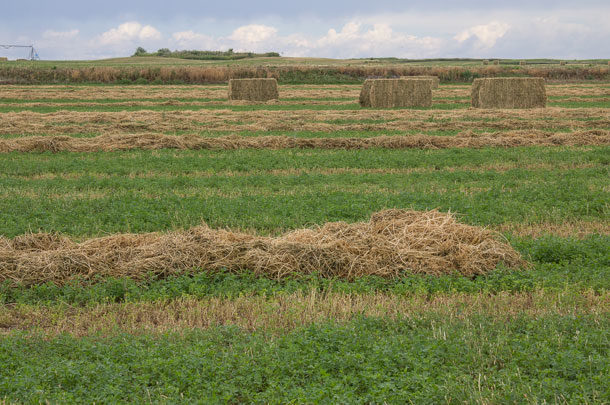For example, recently I saw an article that contained the following statement: “Baling high-moisture forage allows you to harvest earlier and avoid damaging rain when dry hay crops are typically down. And it improves yields in later cuttings. For example, every extra day of delay (waiting to bale an alfalfa crop) amounts to a 6 percent yield loss on the following cutting. Therefore, waiting five days to bale hay can mean a 30 percent yield reduction.”
Does this make sense to you? The overall idea of getting hay off the field as fast as possible may be indisputable, but do hay growers really lose one-quarter to one-third of their potential yield at next cutting by taking the usual four to six days to dry and bale their hay?
I found that last part hard to believe, so I looked for the data that might support the statement. There actually is quite a bit of information and data that show the importance of removing alfalfa from the field as soon after cutting as possible.
As expected, most of the data involved getting the alfalfa forage removed as rapidly as possible to avoid weather damage. However, this is based on retaining yield and quality of the current cutting and does not have a direct impact on the next cutting.
Still, there are reasons why removal rate influences next cutting yield. As hay lies on the field, it slows down plant regrowth and can even smother plants. This effect is seen best in windrow stripes in fields where harvest has been delayed due to slow drying, rain or other factors. And in irrigated fields, delayed removal of hay also can mean delayed addition of irrigation water, resulting in slower growth until moisture is received.
Another factor influencing yield at next cutting is wheel traffic during the current harvest. In fact, it is data from research documenting this effect that may have led to the earlier statement about having a 6 percent yield loss for every extra day of delay.
Research from Wisconsin, Minnesota and Kentucky measured an average 12 percent yield loss at next cutting when alfalfa was driven on two days after cutting, and there was a 30 percent yield loss when driven on five days after cutting. Similar results have been reported in many other states.
These data appear to confirm the earlier statement. However, that statement’s interpretation of the data overlooked the rest of the story. The yield reductions that were reported from this research only came from plants that had been driven on repeatedly, back and forth, side by side, as many as three times at the designated two or five days after cutting. Thus, the wheel traffic was quite intense, and the data did not include the yield from that portion of the field that received no wheel traffic.
So, how much wheel traffic does a typical alfalfa field receive during an individual cutting? Of course, many factors are involved, but most controlled, detailed observations indicate that 50 to 70 percent of the field receives at least one wheel traffic pass during each harvest from tractors, mowers or windrowers, rakes, balers, wagons, etc. That’s a lot of potential damage, but it also suggests that 30 to 50 percent of the field remains unaffected. As a result, total yield loss is likely quite a bit less than that experienced directly in the wheel tracks.
Furthermore, many factors will influence how much yield loss actually will occur due to delayed harvest and wheel traffic. Equipment size, wheel placement, alfalfa variety, soil conditions, regrowth rate, alfalfa’s ability to compensate and fill in, etc., all affect the amount of yield loss in an individual field. Implying that next cutting’s yield will automatically be 6 percent lower if forage removal is delayed another day is an over-simplification and fails to account for the non-traffic areas. In “real life,” the yield loss to the entire field due to an extra day’s delay in removal may be almost immeasurable to more than double the quoted 6 percent.
I sympathize with the author of the earlier statement. We all want and try to give specific answers, myself included. However, we must also understand the complexity of agricultural production – the biology, the weather, the geography, the management – when we try to get and give exact predictions and measurements. That includes recognizing the conditions and limitations of any estimates or measurements. We get tired of answers that begin with, “It depends.” But the fact is that it really does depend. Discovering, reporting and realizing that “real life” results do depend, that is the rest of the story. FG
Bruce Anderson is an extension forage specialist with the University of Nebraska – Lincoln. Email Bruce Anderson.
PHOTO: In a field of rained-on hay, many factors influence yield loss due to delayed harvest and wheel traffic, such as equipment size, wheel placement, alfalfa variety, soil conditions and regrowth rate. Photo by Lynn Jaynes.










